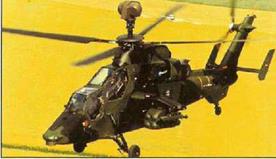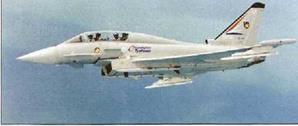Eurocopter Tiger
|
 |
 |
|
T |
he Eurocoptei Model 665 Tiger/Tigre was
developed to meet a Franco-German requirement for a next-generation anti-tank helicopter (German PAH-2 ano French army НАС). Development began in 1984, and resumed in March 1987 (after reappraisal) in a modified form to cover a common antitank version for the two armies, and an armeo escort version (HAP) for the French army. A development contract awarded to Eurocopter in November 1989 provides for construction of five prototypes including two in full anti-tank Tiger (GermanyVTigre (France) configuration and one as the escort Gerfaut.
The Tiger has a slender fuselage with two seats in tandem, stepped and offset to each side of the centreline. The structure makes extensive use of composite materials, and an advanced four-bladed composite semi-rigid main rotor is fitted. Other design features include Spheriflex tail rotor and fixed tricycle undercarriage with single wheels and high energy absorption.
The original German army PAH-2 Tiger was a dedicated anti-tank variant, but was redesigned as a more flexible multi-role aircraft under the designation UHT (originally UHU). with a mast-mounted FLIR night-vision system for the WSO, and з nose – mounted FLIR for the pilot. The aircraft is able to carry up to eight HOT 2 or Trigat anti-armour missiles, or four HOTs and four Stinger 2 AAMs for self-defence. Germany has a requirement for 212
UHTs, ar. d the first 80 have been ordered. The first 115 French army Tigers will be Tiger HAPs. Originally known as the Gerfaut, HAP is an escort and fire-support variant, with no mast-mounted sight, but with e roof-mounted TV, FUR, laser rangefinder and direct-optics sensors, and with an undernose 30-mm cannon turret – France will later receive 100 dedicated anti-tank Tiger HACs (renamed from the original ‘Tigre’l, with a UHT-type mast-mounted sight and other improvements.
The first Tiger prototype flew on 27 April 1991, at first with a mast-mounted sight, but later reconfigured with a roof-mounted sight in the Gerfaut configuration. It was once expected that the French army would receive Gerfauts in 1994 and Tigres in 1999, with the Bundeswehr receiving its first UHU Tigers in 1998. Service introduction is now scheduled for 2003. A joint French/German training centre has been established at Le Luc, in France. The Tiger was unsuccessfully offered to the British and Dutch armies. A HAP-based variant, the Aussie Tiger, is a contender in the Australian Air 87 competition.
The German Army Tiger UHT configuration has a mast-mounted sight. It has no undernose cannon though one may be added in the years to come.
 |
The Eurofighter consortium was officially formed in June 1986 by Britain. Germany and Italy (soon joined by Spain) to produce an air superiority fighter for service from the late 1990s. This ‘ollowec the issue of an outline Air Staff Target by the four partners, plus France, in 1983. The Eurofighter design drew heavily on BAe’s Experimental Aircraft Programme (EAP), and a number of other technology demonstrator programmes. The twin-RB.199 EAR technology demonstrator first flew in August 1986 and amassed invaluable data before retirement in May 1991, The Eurofighter copied EAP’s unstable canard delta layout, adding active digital fly-by-wire flight controls, advanced avionics, multi-function cockpit displays, carbon-fibre composite construction and extensive use of aluminium-lithium alloys and titanium.
The new ECR-90 multi-mode pulse-Doppler look – up/look-down radar was selected for development in May 1990, building on the proven and highfy – regarded Blue Vixen used by the Sea Harrier. While optimised for AMRAAM use, ECR-90 also provides CW illumination for SARH AAMs. The radar is supplemented by an IRST Integrated defensive aids comprise missile approach, laser and radar warning systems, wingtip ESM/ECM pods.
Two of the Seven Eurofighter development aircraft, the British-built DA4 (seen here) and Spain’s DA6, were built in two-seat configuration.
chaff/flare dispensers and a towed radar decoy.
A development contract signed in late 1988 covered the building and testing of eight EFA prototypes (though this total was subsequently reduced to sevenl, In 1992, Germany demanded major cost – reductions, triggering major project reviews and leading to major delays, against threats of withdrawal. Various less capable ‘New EFA’ configurations were studied before Germany decided to procure a smaller number of standard aircraft, stripped of their advanced DASS, and re-christened as the Eurofighter 2000- The original requirement for 765 EFAs (250 each for the RAF and the Luftwaffe, 165 for the AMI and 100 for the Ejercito del Airej was cut back and now stands at 620, (232 for the RAF, 180 for the Luftwaffe. 130 for Italy and 103 4or Spain!. The name Typhoon was adopted for export aircrs*t (and for the RAF’s Eurofighte’s) in 1998, and strong interest in the aircraft has already been expressed by Greece and Norway.
The prototype EFA 2000 made its long-awaited first flight on 27 March 1994 from Marching. Germany, and began what was to be a successfu (if occasionally troubled) flight test programme. The first production Eurofighters were rolled out during 2001, and service entry is expected in 2003.

|












